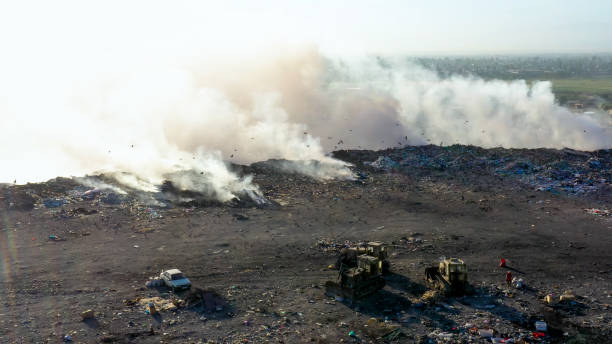As urbanization continues to accelerate, landfills, as one of the main ways to deal with urban solid waste, play an important role in maintaining urban hygiene and public health. However, landfills release a large amount of greenhouse gases during operation, especially methane, which not only has a strong greenhouse effect, but also has a profound impact on the air quality of the surrounding areas. As the public’s attention to air pollution and climate change issues increases, the environmental risks caused by landfill methane emissions have become increasingly noticeable.
Methane’s Air Pollution Impact Path
As a colorless and odorless gas, methane has a low concentration in the surface atmosphere, but its potential harm cannot be underestimated. On the one hand, it is a precursor to ozone generation and participates in the formation of near-ground ozone, which has adverse effects on human health, crop growth and ecosystems; on the other hand, the global warming potential (GWP) of methane is 28 times that of carbon dioxide, and it has a strong greenhouse effect, which will aggravate climate change and then react to the deterioration of air quality.
Around landfills, methane leakage may not only cause safety hazards such as gas explosions, but also lead to abnormal increases in the concentration of harmful gases in the local air, forming potential health risk areas. If the monitoring methods are delayed or inaccurate, risk events often accumulate silently.
Multi-Point Control: From Extensive Monitoring To Fine Governance
Traditional landfill methane monitoring methods are mainly fixed-point sampling, which has the disadvantages of limited coverage and slow response time, and it is difficult to meet the increasingly stringent environmental protection standards and public expectations. The application of a new generation of portable and integrated methane detectors is gradually promoting the transformation of landfill gas emission monitoring to real-time, intelligent, and multi-point.
At present, some high-performance detection equipment has high-sensitivity infrared sensing technology and laser detection modules, which can operate stably under complex climate and terrain conditions, and support remote data upload and visual analysis. In particular, the deployment of multi-point detection nodes in large-scale landfills can effectively capture small leakage sources and abnormal emission areas, realize grid control, and effectively identify “blind spots” and “high-risk points”.
Case Study: Air Governance Measures In Illinois, Usa
In Illinois, USA, a large solid waste management company introduced an advanced drone-mounted methane detection system and a coordinated deployment strategy of ground detectors to cope with regulatory pressure and complaints from surrounding residents caused by methane leaks. The drone carries a high-sensitivity infrared methane sensor to conduct aerial surveys over the landfill area and quickly locate areas with abnormal methane concentrations. Ground detectors are set up at key points to achieve real-time data collection and historical trend analysis.
After the system was put into operation, it not only effectively reduced the total amount of methane emissions, but also improved the ability to identify potential safety hazards at an early stage. According to data released by the company, within one year after the implementation of the new monitoring system, the average methane concentration at its landfill site dropped by about 35%, and related air quality complaints also decreased by more than 60%. This case shows that accurate monitoring can not only optimize emission control strategies, but also have direct economic and social benefits.
Technological Support Behind Refined Monitoring
The reason why methane detectors are able to perform monitoring tasks in complex scenarios is due to their integrated core technology. For example, some methane telemeters combine the detection laser with the visible light sensor for calibration, and use the tunable diode laser absorption spectroscopy (TDLAS) technology to perform real-time data analysis. At the same time, they are integrated with the drone system to keep the detection equipment away from the leak point, and can achieve ppm-level precision monitoring. At the same time, through the support of the three-axis gyro stabilization system, GPS positioning module and 5G/4G communication function, the equipment can be flexibly combined with drones, fixed sites, and mobile platforms to adapt to both dynamic and static usage scenarios.
Conclusion: Breaking The Barrier Of “Invisible Pollution”
The pollution characteristics of methane are different from traditional particulate matter or sulfide. Its “hiddenness” and “hysteresis effect” often make it ignored. However, with the iterative upgrade of monitoring technology, we have the ability to break the cognitive barrier of this invisible pollution. Through the point-based, multi-dimensional, and high-frequency methane detection methods, the air quality management of landfills is gradually entering a new stage of scientific and intelligent development.
In the future, with the tightening of methane emission standards and the establishment of a carbon trading market, accurate quantification and monitoring of methane emissions will not only be an environmental protection requirement, but also a key threshold for the sustainable development of enterprises. Efficient and intelligent methane detectors will undoubtedly play an increasingly core role in this.
